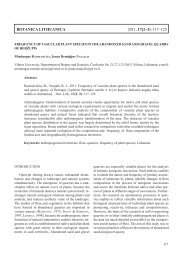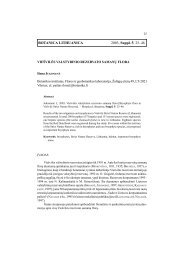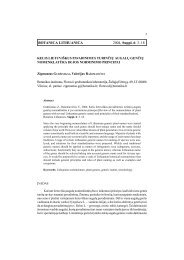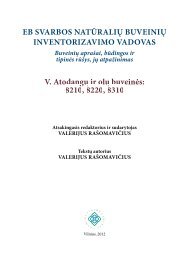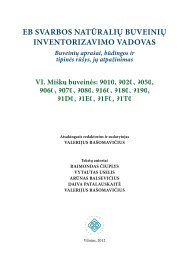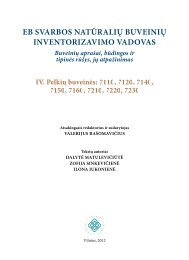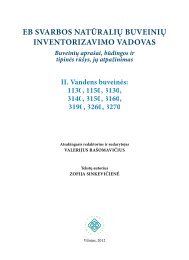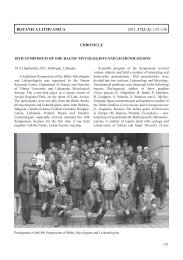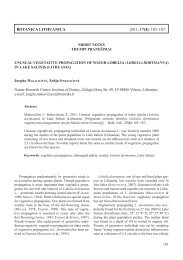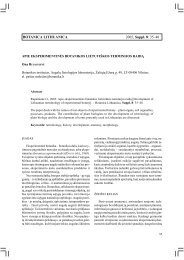FUNGI AND LICHENS IN THE BALTICS AND BEYOND XVIII ...
FUNGI AND LICHENS IN THE BALTICS AND BEYOND XVIII ...
FUNGI AND LICHENS IN THE BALTICS AND BEYOND XVIII ...
Create successful ePaper yourself
Turn your PDF publications into a flip-book with our unique Google optimized e-Paper software.
EPIPHYTIC <strong>AND</strong> EPIXYLIC <strong>LICHENS</strong> <strong>IN</strong> GREAT CORMORANT COLONY<br />
J. MOTIEJŪNAITĖ 1 , G. ADAMONYTĖ 1 , R. TARAŠKEVIČIUS 2<br />
1 Institute of Botany, Nature Research Centre, Žaliųjų Ežerų Str. 49, LT-08406 Vilnius,<br />
Lithuania<br />
2 Institute of Geology and Geography, Nature Research Centre, Ševčenkos Str. 13,<br />
LT-03223 Vilnius, Lithuania<br />
E-mails: jurga.motiejunaite@botanika.lt, grazina.adamonyte@botanika.lt,<br />
taraskevicius@geo.lt<br />
In year 2010 a project was started aiming to investigate changes in the biotic and<br />
abiotic components of forest ecosystem induced by a colony of great cormorant<br />
(Phalacrocorax carbo sinensis). Lichens were among the study objects; they were<br />
investigated on all available substrate groups in various bird colony influence zones.<br />
Results of the preliminary investigations show that cormorant colony activities<br />
dramatically changed lichen communities which have transformed into species-poor<br />
nitrophilic assemblages with prevailing two highly nitrotolerant lichens, often forming<br />
monospecific communities on bark (Phaeophyscia orbicularis) or vertical wood surfaces<br />
(Xanthoria candelaria) in the centre of the colony. Outside the colony acidophilic and<br />
neutrophilic communities prevailed which were transformed into very much depauperated<br />
assemblages at the colony edges and into lichen desert in the most active part of the colony.<br />
Changes in lichen species numbers, composition, abundance and substrate<br />
colonization correlated with significant alterations of substrate chemical properties. Lichen<br />
desert in the most active part of the colony was, however, related not to the extreme elevation<br />
of pH and nutrient (N/P) levels but rather to the die-away of acidophilic lichen communities<br />
and apparently to too short time for establishment of nitrophilous species, as it is known that<br />
time span between the appearance of first cormorant nests and death of a tree makes only 2–5<br />
years.<br />
Acknowledgements. This research was funded by a grant No LEK-23/2010 from the<br />
Research Council of Lithuania.<br />
STUDIES OF LICHEN DIVERSITY ON <strong>THE</strong> ANTHROPOGENIC SUBSTRATES <strong>IN</strong><br />
OLD CEMETERIES<br />
I. PRIGOD<strong>IN</strong>A LUKOŠIENĖ, V. KUODYTĖ<br />
Department of Botany and Genetics, Vilnius University, M. K. Čiurlionio Str. 21/27, LT-<br />
03101 Vilnius, Lithuania<br />
E-mails: ingrida.prigodina@gf.vu.lt, wilmmius@gmail.com.<br />
Studies of lichen diversity on the anthropogenic substrates in old Lithuanian<br />
cemeteries were started on 2010–2011. The research began at the Bernardinai cemetery<br />
established in 1810 in Vilnius. During the research 37 taxa of lichens were identified on the<br />
man-made substrates in Bernardinai cemetery. Analysis of morphological structure showed<br />
that foliose lichens dominated on the anthropogenic substrates. Number of fruticose lichen<br />
was quite small (barely one tenth of found species). Analysis of life forms showed that all<br />
studied substrates are dominated by Physcia lichen life form (one third of identified species).<br />
Exophleoidic and Parmelia- life forms of lichens were also abundant. During the research in<br />
Bernardinai cemetery lichen taxa were recorded on 6 types of substrates: on metal (22 taxa of<br />
lichens), on granite (30), on concrete (20), stone (3), on stone – concrete gravestones (10), on



